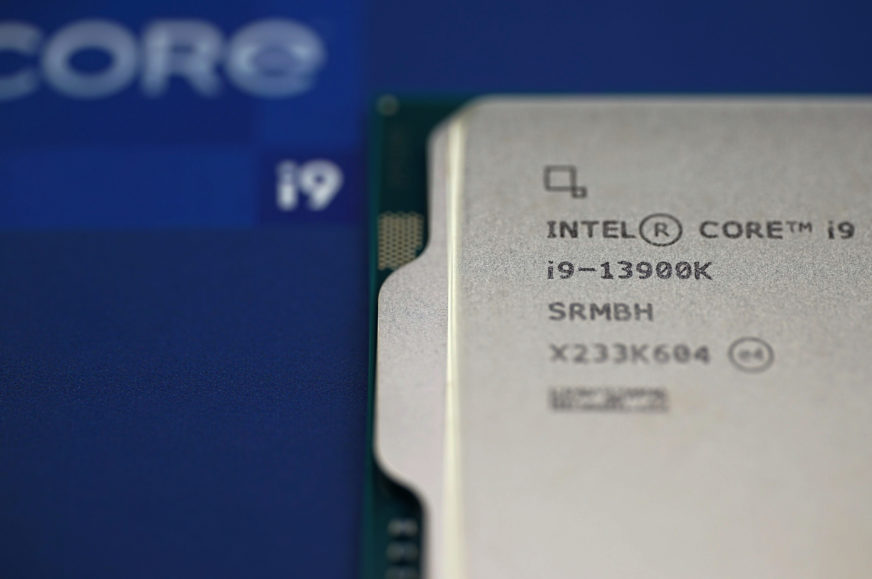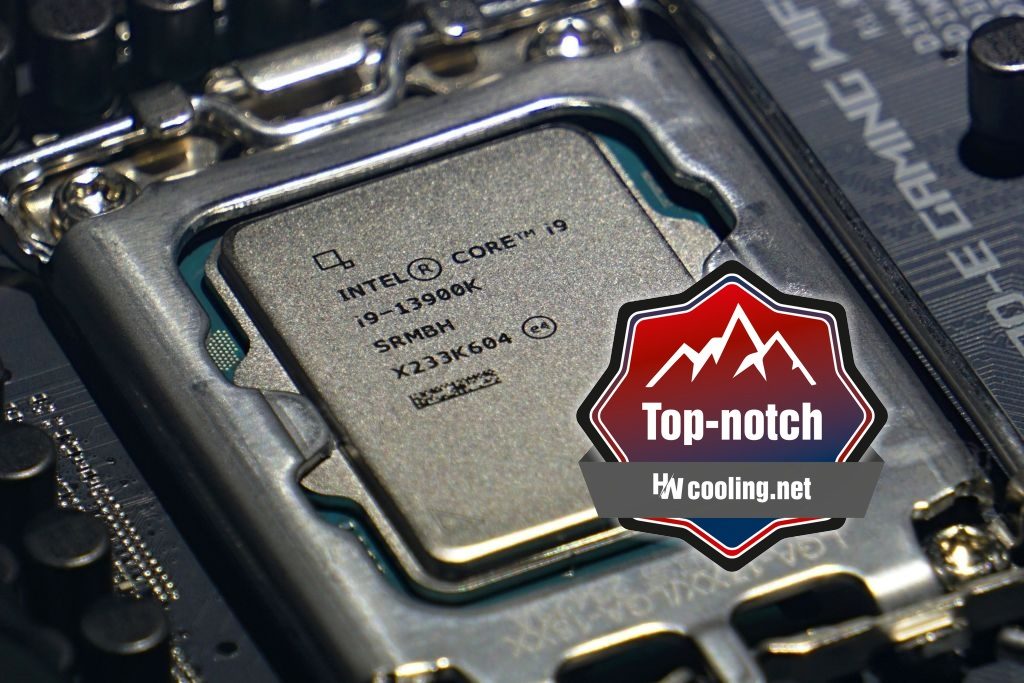Conclusion
A fully active Intel Raptor Lake CPU chip, that’s tremendous performance for all situations, but also a lot of worries. These revolve around how to use this great potential and not hold anything back. There are more obstacles than usual. When it’s not on a software basis, it’s a struggle with cooling for a change. And you already know that the 13th-generation Intel Core CPU is sometimes more efficient than the Ryzen 7000.
Conclusion
The same way the Ryzen 7000 CPUs did well, (we already tested models R9 7900X and R5 7600X) Intel also scores with Raptor Lake. From a multi-threaded performance perspective the jump in efficiency across generations is really significant. At similar power draw, the Ci9-13900K has about three times the performance compared to the Ci9-11900K, and 2.5 times the performance of the Ci9-10900K.
Compared to the Ci9-12900K, it’s “only” some 50 %, but in the charts where we’re looking at the performance per unit of power draw ratio, it looks better than ever from Intel’s point of view. Naturally, this is also because while Intel is increasing efficiency, AMD is decreasing it by increasing power limits. However, the Ryzen 9 7900X is still more efficient compared to the Ci9-13900K and the lead of the Ryzen 9 7950X won’t be any smaller. We don’t have the R9 7950X tests published yet, but they are on the way. We’re definitely not shying away from confronting this processor with the Ci9-13900K, but the gap between the release of the Ryzen 7000 and the Raptor Lake processors was too narrow for us to be able to test and rank all the models as well as we would have liked.
Either way, a Core i9-13900K for similar money (and in the context of an entire platform with DDR4 memory, possibly less) than you’d pay for a Ryzen 9 7900X is 30–40 % faster in 3D rendering., at (de)compression then around 20 %. In a similar ratio, but already in favor of the Ryzen 9 7900X, the AMD processor may again be faster at (de)encryption. When video encoding with x264/x265, the Core i9’s edge is some 12–20 %, which also benefits this processor in video editing applications, in Adobe Premiere Pro or in DaVinci Resolve Studio. Also noteworthy are the advantages in computing various physics simulations, for which the Core i9-13900K has a more attractive price/performance ratio at the expense of weaker efficiency.
In any case, raw multithreaded performance is not one of the Core i9-13900K’s strongest points. This is undoubtedly performance in single-threaded applications, where Raptor Lake is without a doubt more attractive than the equivalent Ryzen 9 79×0 processors. Compared to the R9 7900X, the Ci9-13900K has higher performance at lower power draw. In practice, single-threaded performance often manifests itself in faster responses in web environments or when working with some graphic editor filters (including Adobe Photoshop and Affinity Photo), that do not support GPU acceleration or multiple CPU cores. High performance in single-threaded applications given the very high frequencies was expected, but that Intel can do it at lower power draw is already a surprise. However, despite high efficiency and relatively low power draw in single-threaded loads, a more powerful cooler is needed for the core temperature under load not to exceed 70 °C. Only under such conditions does the processor hold its maximum 5.8 GHz. But even after exceeding this limit TVB does not make big cuts and the clock speed reduction is only symbolic, by 100 MHz.
The bigger clock speed drop is in multi-threaded loads, where after a few seconds speeds drop by 400–500 MHz from a maximum of 5.5 GHz (This is matched by a drop in power draw, which then stabilises at around 290 W). The more powerful the cooler you use, the longer it will maintain the initial power draw of approximately 350 W. Not even the most powerful AIO liquid coolers can handle such power draw for the long term according to the needs of Raptor Lake. It’s always only a matter of time before individual cores start hitting 100°C, at which point the clock speeds start to drop. And paradoxically, at least on the Asus ROG Strix Z790-E motherboard, even disabling ABT (Advanced Boost Technology) won’t change anything. How the processor will react to such high temperatures in other motherboards, you will find out in a relatively short time. The benchmarks will also show later how the efficiency of the Ci9-13900K changes due to the power limitation by TDP (125 W) at lower power draw.
The Core i9-13900K is, among other things, the fastest “gaming” processor. In terms of the average of all games, the edge over the Ci9-12900K can be up to 14 %, over the R7 5800X3D up to 11 %. In some games, the Ci9-13900K may run into the limits of the OS scheduler, which may misallocate E cores to more demanding tasks or work incorrectly with HT. This can happen, for example, in CS:GO, in DOOM Eternal and the most in Total War Saga: Troy, where the Ci9-13900K seemingly illogically ends below the Ci9-12900K. In TWST, the naturally lower power draw is adequate to the lower gaming performance.
For most games, however, the Ci9-13900K is the number one performer, even at the relatively higher resolution (compared to 720p) of 1080p. This is how the Core i9 Raptor Lake processor fares in Assassin’s Creed: Valhalla, in Borderlands 3, in F1 2020, in Microsoft Flight Simulator or in Metro Exodus. For Shadow of the Tomb Raider, however, the Ryzen 9 7900X is already looking better. In games, however, what is true of single-threaded performance is no longer true of efficiency. Of the Ci9-13900K and R9 7900X pair, Intel’s processor is always the less efficient. AMD pulls the longer end of the rope in this micro-battle with the R9 7900X, even if only by a little bit.
When it’s all summed up and underlined, if we’re targeting a similar price range of builds, the Core i9-13900K played out a pretty nice tie with the Ryzen 9 7900X. And hopefully, this is also the start of a bigger effort by both manufacturers to again make one of them properly stand apart from the other when it comes to the quality characteristics of mainstream processors for desktops.
English translation and edit by Jozef Dudáš
| Intel Core i9-13900K |
| + On mainstream platforms, top-notch multi-threaded performance |
| + Excellent single-threaded performance, higher than Ryzen 9 79x0X... |
| + ... and at the same time lower power draw. Raptor Lake is more efficient even in the Core i9 class |
| + The highest performance for a gaming PC available today |
| + "Universal" processor, fits every usage scenario |
| + 24 cores and 32 threads on a mainstream platform |
| + Very high performance per clock (IPC) |
| + Modern 7nm manufacturing node |
| + Extremely high clock speeds |
| + Favourable price/performance ratio for high-end |
| - Need for a very powerful cooler if you want to keep performance at the maximum |
| - Compared to Ryzen 9, weaker efficiency (performance per watt) for multi-threaded tasks |
| Approximate retail price: 589 EUR |
Games for testing are from Jama levova
Special thanks to Blackmagic Design (for a DaVinci Resolve Studio license), Topaz Labs (for licenses for DeNoise AI, Gigapixel AI and Sharpen AI) and Zoner (for Photo Studio X license)
- Contents
- Intel Core i9-13900K in detail
- Methodology: performance tests
- Methodology: how we measure power draw
- Methodology: temperature and clock speed tests
- Test setup
- 3DMark
- Assassin’s Creed: Valhalla
- Borderlands 3
- Counter-Strike: GO
- Cyberpunk 2077
- DOOM Eternal
- F1 2020
- Metro Exodus
- Microsoft Flight Simulator
- Shadow of the Tomb Raider
- Total War Saga: Troy
- Overall gaming performance
- Gaming performance per euro
- PCMark and Geekbench
- Web performance
- 3D rendering: Cinebench, Blender, ...
- Video 1/2: Adobe Premiere Pro
- Video 2/2: DaVinci Resolve Studio
- Graphics effects: Adobe After Effects
- Video encoding
- Audio encoding
- Broadcasting (OBS and Xsplit)
- Photos 1/2: Adobe Photoshop and Lightroom
- Photos 2/2: Affinity Photo, Topaz Labs AI Apps, ZPS X, ...
- (De)compression
- (De)cryption
- Numerical computing
- Simulations
- Memory and cache tests
- Processor power draw curve
- Average processor power draw
- Performance per watt
- Achieved CPU clock speed
- CPU temperature
- Conclusion










